Extreme Value Analysis for Mixture Models with Heavy-Tailed Impurity
Abstract
:1. Introduction
2. Weibull-RV Mixture
- Gumbel distribution, , , if and only if any of the following conditions is satisfiedIn all cases, possible choice of the normalising sequences is
- Fréchet distribution with parameter α, , , if and only if any of the following conditions is satisfiedIn all cases, one can takewhere for
3. Weibull-Truncated RV Mixture
- 1.
- Gumbel distribution, , , if and only if any of the following conditions is satisfied
- 1.1
- as ;
- 1.2
- as , and moreover
In all cases, possible choice of the normalising sequences is given by (12). - 2.
- Fréchet distribution with parameter α, , , if and only if any of the following conditions is satisfiedIn all cases, one can take in the form (13).
- 3.
- Special cases:
4. Simulation Study
5. Modelling the Log-Returns of BMW Shares
- Separation of components. For each , the sample is divided into two parts corresponding to the first and the second components in (14), where the slowly varying function L is equal to a constant. For such partition we assign all observations except the greatest order statistics of the whole sample to the first component and test the goodness-of-fit for Weibull distribution by the Kolmogorov–Smirnov criterion. The values of are taken on a grid from 0 to 0.5 with a step of 0.001. From the second plot in Figure 3 it can be seen that there is an evident peak in p-values, which corresponds to some value of the mixture parameter, which we denote by . The upper order statistics are assumed to come from the heavy-tailed part.Next, let us show that the sequence vanishes as n grows. For all the parameter is estimated as the proportion of elements corresponding to the second component. The same procedure is applied for each to the sample . The results are illustrated by Figure 4. The first plot in two rows indicates that in both cases declines with n, though in case of negative log returns the decrease is not so evident. From the second plot one can see that with appear to tend to infinity. Therefore, as suggested by Theorems 1 and 2, we examine the asymptotic behaviour of the ratio for different values of . For both positive and absolute values of negative log returns we get that for this ratio decreases rapidly.
- Model selection. Based on the partition obtained on the previous step, the decision between truncated and non-truncated distributions for the second component is made based on the test proposed by Aban, Meerschaert and Panorska [20]. From Figure 5 one observes that the null hypothesis of non-truncated law is not rejected for both positive and negative log returns since the p-values are significantly larger than 0.05. Thus, it can be concluded that the model (3) is more appropriate for the considered data. The Kolmogorov–Smirnov test does not reject the null of Pareto distribution for the observations assigned to the second component with p-values 0.971 and 0.925 for positive and negative log returns, respectively. It should be noted that in both cases the Pareto distribution does not fit the whole sample, since the p-values are smaller than .
- Estimation of parameters. The parameters of the first and second components are estimated by the maximum-likelihood approach. The estimated values are presented in Table 3. Since is equal to 0.483 for positive log returns and 0.484 for absolute values of negative, from Figure 4 we conclude that the assumption (9) is fulfilled with , and therefore the limit distribution for maxima is the Fréchet distribution, see item 2 in Theorem 1.It is worth mentioning that for both positive and absolute values of negative log returns we get , which is completely coherent with general empirical results for financial returns and addresses the common critique against models with infinite variance, see [19].
- Validation of the model.Figure 6 depicts the true density of positive (top left) and absolute values of negative (top right) log returns superimposed with densities of 100 simulations from the mixture (3) with the corresponding parameter estimates. The constructed model is also verified by the empirical confidence intervals for the sample quantiles based on 100 simulations. The results are given in Table 4 and Table 5 and illustrated by Figure 6. These intervals are reasonably small and contain all true values of quantiles. Next, we apply the chi-squared test with the maximum likelihood estimates of parameters. Due to the known theory (see Section 4.4 from [21]), the statistics of this test converge to the chi-squared distribution with degrees of freedom, where K is the number of subintervals used for the chi-squared test, and D is the dimension of the parameter space (in our setting, ). Using , we get the p-values 0.73 and 0.21 for positive and negative log returns, and therefore do not reject the null hypothesis. Finally, we arrive at the outcome that the model (3) is appropriate both for positive and absolute values of negative log returns of BMW at the considered time scale.
6. Conclusions
- We model the heavy-tailed impurity via the mixture distribution with varying parameters and (following the ideas from [8,9]) consider the resulting model as a triangular array. The notion of heavy-tailed impurity is not new, but all previously known probabilistic results are concentrated only on the classical limit laws, see [2,16]. In this paper, we establish the limit laws for the maximum in these models.
- The paper delivers an example of the triangular array such that its row-wise maximum has (under proper normalisation) 6 different distributions, depending on the rates of the varying parameters. To the best of our knowledge, all previous articles on the extreme value analysis for triangular arrays deal with the convergence to the limit law having twice differentiable cdf ([5,7]) or closely related to the classical extreme value distributions ([6]), while some limits in our examples are discontinuous and very different from the classical laws.
- We show the difference between various types of truncation for the regularly varying distributions used for modelling the impurity. Our conditions (17)–(18) are close to soft and hard truncation regimes introduced in [9], leading to similar (but not completely the same) outcomes for our mixture model as for the model considered in [9]. Moreover, unlike previous papers, we study in details the case of intermediate truncation regime (19).
- For practical purposes we describe the four-step scheme for the application of this model to the asset price modelling. This approach can be considered as a possible development of the idea that the distribution of stock returns is in some sense between exponential and power law. A comprehensive discussion of this idea can be found in [11].
Author Contributions
Funding
Institutional Review Board Statement
Informed Consent Statement
Data Availability Statement
Conflicts of Interest
Appendix A. Classical EVA for the Mixture Model
Appendix B. Proof of Theorem 1
- (i)
- Let . As as by the slow variation of (see (6)), we getand therefore we deal with the extreme value analysis of the Weibull law. Since is a von Mises function, i.e., can be represented aswith and , we get that the limit distribution is Gumbel under the choice with
- (ii)
- Let as . This case is divided into several subcases, depending on the relation between and
- First, let us consider . Thenas . Therefore,as for all fixed as . Clearly, since is not present in the above limit, one can take . As for , we havei.e., We haveand therefore the limit distribution in (A1) is non-degenerate (and is actually the Fréchet distribution) if and only ifIt would be a worth mentioning that depends on the function L via the equality (A2). Let us recall that is slowly varying and thereforeNow, sincewe get that for the condition (A3) to be fulfilled, it is sufficient that the right-hand side tends to zero as , i.e.,or, equivalently,
- Let the norming constants and be chosen in the form (12). Then is the cdf of the Gumbel law ifAs previously, we would like to replace (A5) with another condition without . Once more, we would like to recall that by slow variation ofFrom this we conclude thatand the fact that the right-hand side tends to zero as will imply (A5). In other words, we obtain the Gumbel limit ifor, equivalently, if
- (a)
- Let us first consider the case as . Then one can take and find as the solution to the equationThe limit for the second component in (A1) coincides with the corresponding one in item 2(i) (and leads to the cdf of the Fréchet law), while for the first component we getThe value of the latter limit is zero for all fixed since as , and therefore the limit distribution is Fréchet.
- (b)
- Now, let be such that as . Then the same choice of norming constants as when as leads to the same limits as before. However, the value of (A7) now depends on x, namely,Thus, in this case the limit distribution is equal toAn interesting point is that we get the limit distribution that is not from the extreme value family, having an atom at .
- (c)
- Finally, let be such that as . Then the normalising sequence can be chosen as in item 1, and for the first component we getwhile for the second oneTherefore, in this case the limit distribution is again Gumbel.
Appendix C. Limit Law for the Truncated RV Distribution
Appendix D. Proof of Theorem 2
- (i)
- Let as . By slow variation of , as , therefore, the whole second component disappears. We deal with maxima of a Weibull random variable and obtain the Gumbel limit under the normalisation with in the form (A3).
- (ii)
- Let . By a similar argument as in the previous item,Under the same choice of normalising sequences, we getfor all fixed as . Therefore, the limit distribution is again Gumbel.
- (iii)
- Let as . The further analysis depends on the asymptotic properties of If (17) holds, the proof is based on the observation thatand therefore,From (17) it follow that for any the right-hand side tends to zero as , and therefore as . The rest of the proof in this situation follows the same lines as the proof of Theorem 1. Other cases are more complicated, and we divide the further proof into several steps.
- Now assume that (9) holds. In this case, (A10) can be violated. In fact,with some . From (18), it follows that the right-hand side is infinite if , and has an unknown asymptotic behaviour otherwise. The lower bound is given bywhere for , the right-hand side tends to zero as , while otherwise the asymptotic behaviour is again unknown. In this case, we conclude that if is such that (A10) holds, the non-degenerate limit distribution exists and is in fact the Gumbel distribution.
- Finally, in the case (10),because . Since by (A10) there exists such that the right-hand side tends to zero as , we get under proper normalisation the Gumbel limit distribution.
- If (9) holds, then the result turns out to depend on the asymptotic behaviour of . Let us recall that is asymptotically equal to a constant.
- (a)
- If as , we have that as . Thus, as was argued above, the non-degerated limit exists if and only if (A10) holds for all x and n large enough. However, for any ,and therefore the assumption (A10) is violated due to (9). Thus, in this case there exists no non-degenerate limit distribution.
- (b)
- Now consider the case for some as . Let us fix in the form (13). The inequality is equivalent to Under this normalisation, we haveand therefore
- (c)
- If as , one can take the norming constants as in the previous item and obtain the Fréchet limit distribution since and as . The last thing which is crucial here is to check that for all . This inequality follows from
- Finally, let us consider the case (10). As in the previous situations, the limit distribution depends on the asymptotic behaviour of .
- (a)
- Let as . Since then as , we conclude that the non-degenerate limit exists only if (A9) holds. In the considered case, (A9) is equivalent toThe normalising sequence (12) again leads to the Gumbel limit distribution.
- (b)
- If for some as , we have that .
- If , a linear normalising sequence as in (12) leads to the Gumbel limit, since for all and n large enough; see the previous item.
- Therefore, we getAs we see, the limit distribution does not belong to the extreme value family, and has an atom at .
- If , the choice (13) leads to the discrete limit distribution having a unique atom at with probability mass
- (c)
- Lastly, let be such that as . Then the Gumbel limit can be obtained under the normalisation (12) since as , see item (i,c) in Theorem 1. This observation completes the proof.
References
- van den Berg, J.; Nolin, P. Near-critical percolation with heavy-tailed impurities, forest fires and frozen percolation. arXiv 2018, arXiv:1810.08181. [Google Scholar]
- Grabchak, M.; Molchanov, S. Limit theorems and phase transitions for two models of summation of independent identically distributed random variables with a parameter. Theory Prob. Appl. 2015, 59, 222–243. [Google Scholar] [CrossRef]
- Petrov, V. Sums of Independent Random Variables; Springer Science & Business Media: Norwell, MA, USA, 2012; Volume 82. [Google Scholar]
- Meerschaert, M.; Scheffler, H.-P. Limit Distributions for Sums of Independent Random Vectors: Heavy Tails in Theory and Practice; John Wiley & Sons: New York, NY, USA, 2001; Volume 321. [Google Scholar]
- Freitas, A.; Hüsler, J. Condition for the convergence of maxima of random triangular arrays. Extremes 2003, 6, 381–394. [Google Scholar] [CrossRef]
- Anderson, C.; Coles, S.; Hüsler, J. Maxima of Poisson-like variables and related triangular arrays. Ann. Appl. Probab. 1997, 7, 953–971. [Google Scholar] [CrossRef]
- Dkengne, P.S.; Eckert, N.; Naveau, P. A limiting distribution for maxima of discrete stationary triangular arrays with an application to risk due to avalanches. Extremes 2016, 19, 25–40. [Google Scholar] [CrossRef]
- Beirlant, J.; Fraga, A.I.; Gomes, I. Tail fitting for truncated and non-truncated Pareto-type distributions. Extremes 2016, 19, 429–462. [Google Scholar] [CrossRef] [Green Version]
- Chakrabarty, A.; Samorodnitsky, G. Understanding heavy tails in a bounded world or, is a truncated heavy tail heavy or not? Stoch. Model. 2012, 28, 109–143. [Google Scholar] [CrossRef] [Green Version]
- Laherrere, J.; Sornette, D. Stretched exponential distributions in nature and economy: “Fat tails” with characteristic scales. Eur. Phys. J. -Condens. Matter Complex Syst. 1998, 2, 525–539. [Google Scholar] [CrossRef] [Green Version]
- Malevergne, Y.; Pisarenko, V.; Sornette, D. Empirical distributions of stock returns: Between the stretched exponential and the power law? Quant. Financ. 2005, 5, 379–401. [Google Scholar] [CrossRef]
- Bingham, N.H.; Goldie, C.M.; Teugels, J.L. Regular Variation; Cambridge University Press: Cambridge, UK, 1987. [Google Scholar]
- Resnick, S. Extreme Values, Regular Variation and Point Processes; Springer: New York, NY, USA, 2013. [Google Scholar]
- Mikosch, T. Regular Variation, Subexponentiality and Their Applications in Probability Theory; Report Eurandom; Eurandom: Eindhoven, The Netherlands, 1999; Volume 99013. [Google Scholar]
- Embrechts, P.; Klüppelberg, C.; Mikosch, T. Modelling Extremal Events for Insurance and Finance; Springer: New York, NY, USA, 1997. [Google Scholar]
- Panov, V. Limit theorems for sums of random variables with mixture distribution. Stat. Probab. Lett. 2017, 129, 379–386. [Google Scholar] [CrossRef] [Green Version]
- Paulauskas, V. A note on linear processes with tapered innovations. Lith. Math. J. 2020, 60, 64–79. [Google Scholar] [CrossRef] [Green Version]
- Mandelbrot, B. The variation of certain speculative prices. J. Bus. 1963, 1, 223. [Google Scholar] [CrossRef]
- Cont, R. Empirical properties of asset returns: Stylized facts and statistical issues. Quant. Financ. 2001, 1, 223–236. [Google Scholar] [CrossRef]
- Aban, I.B.; Meerschaert, M.M.; Panorska, A.K. Parameter estimation for the truncated Pareto distribution. J. Am. Stat. Assoc. 2006, 101, 270–277. [Google Scholar] [CrossRef]
- Suhov, Y.; Kelbert, M. Probability and Statistics by Example: Volume I. Basic Probability and Statistics; Cambridge University Press: Cambridge, UK, 2005. [Google Scholar]
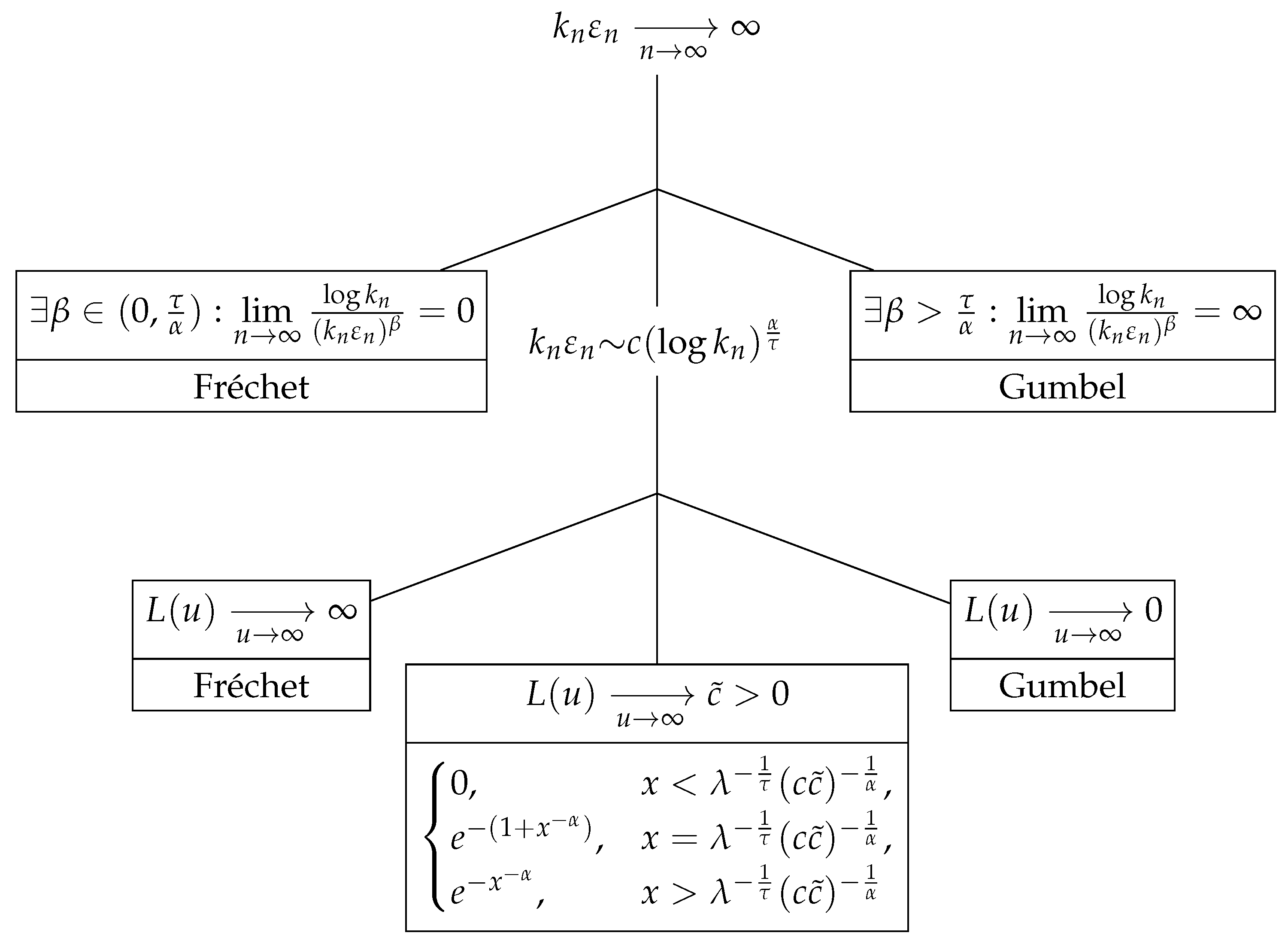

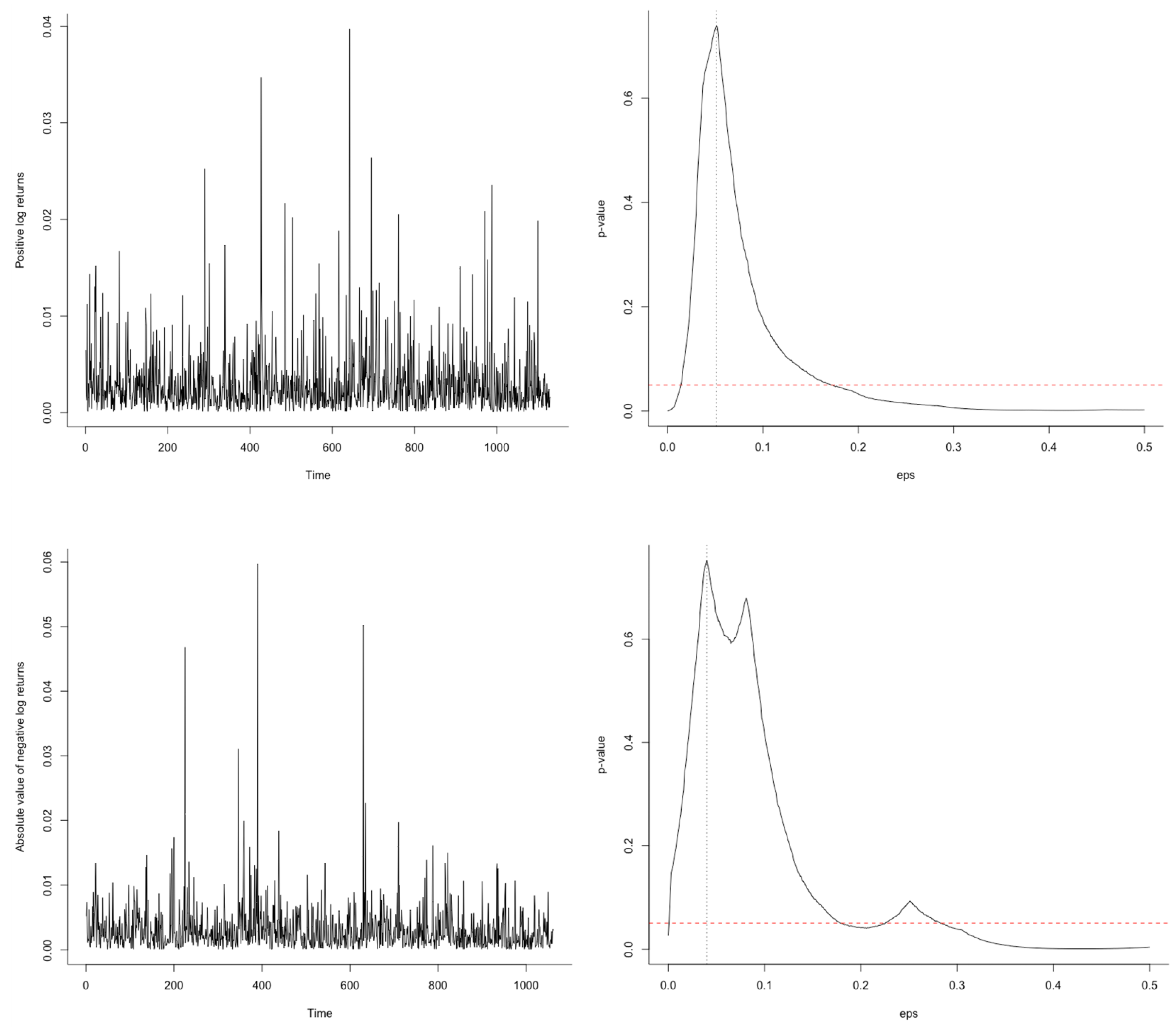
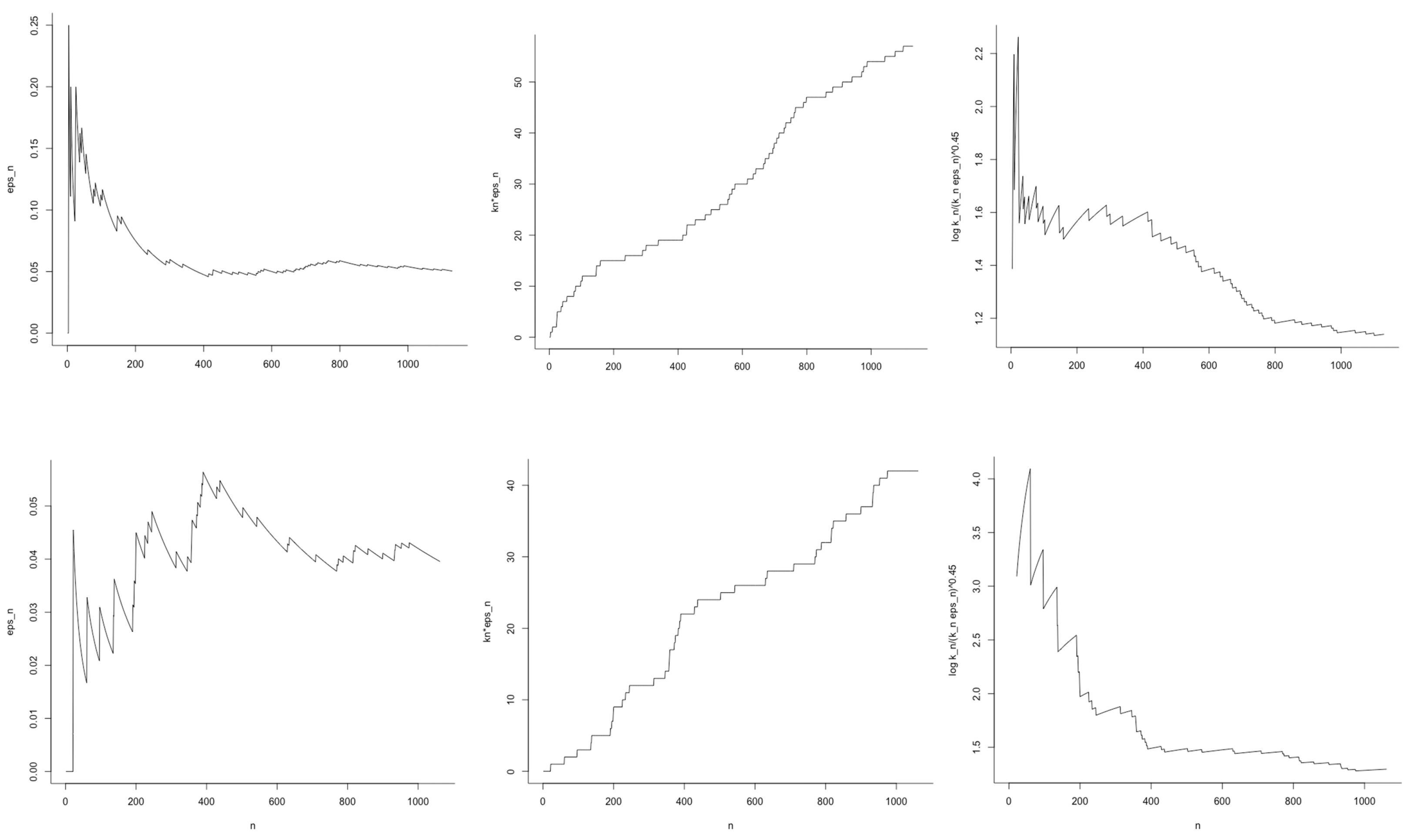
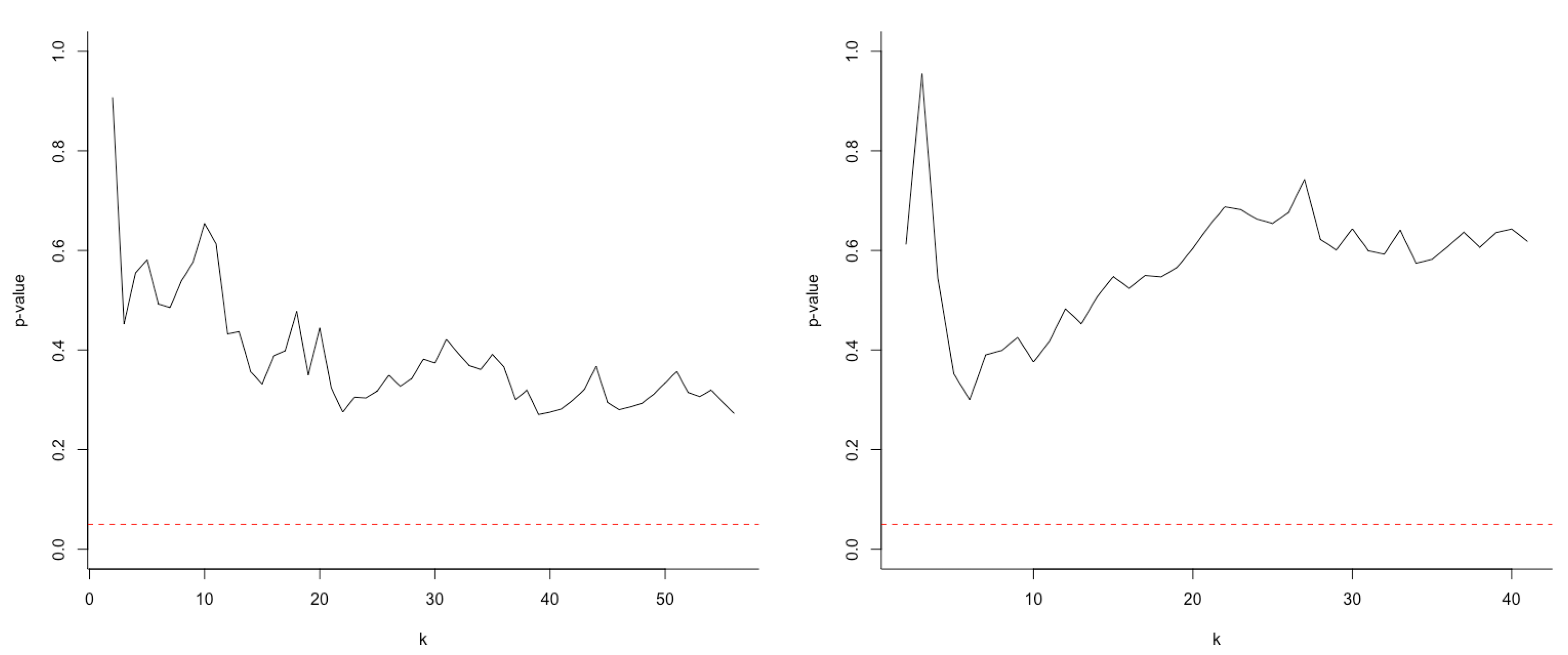
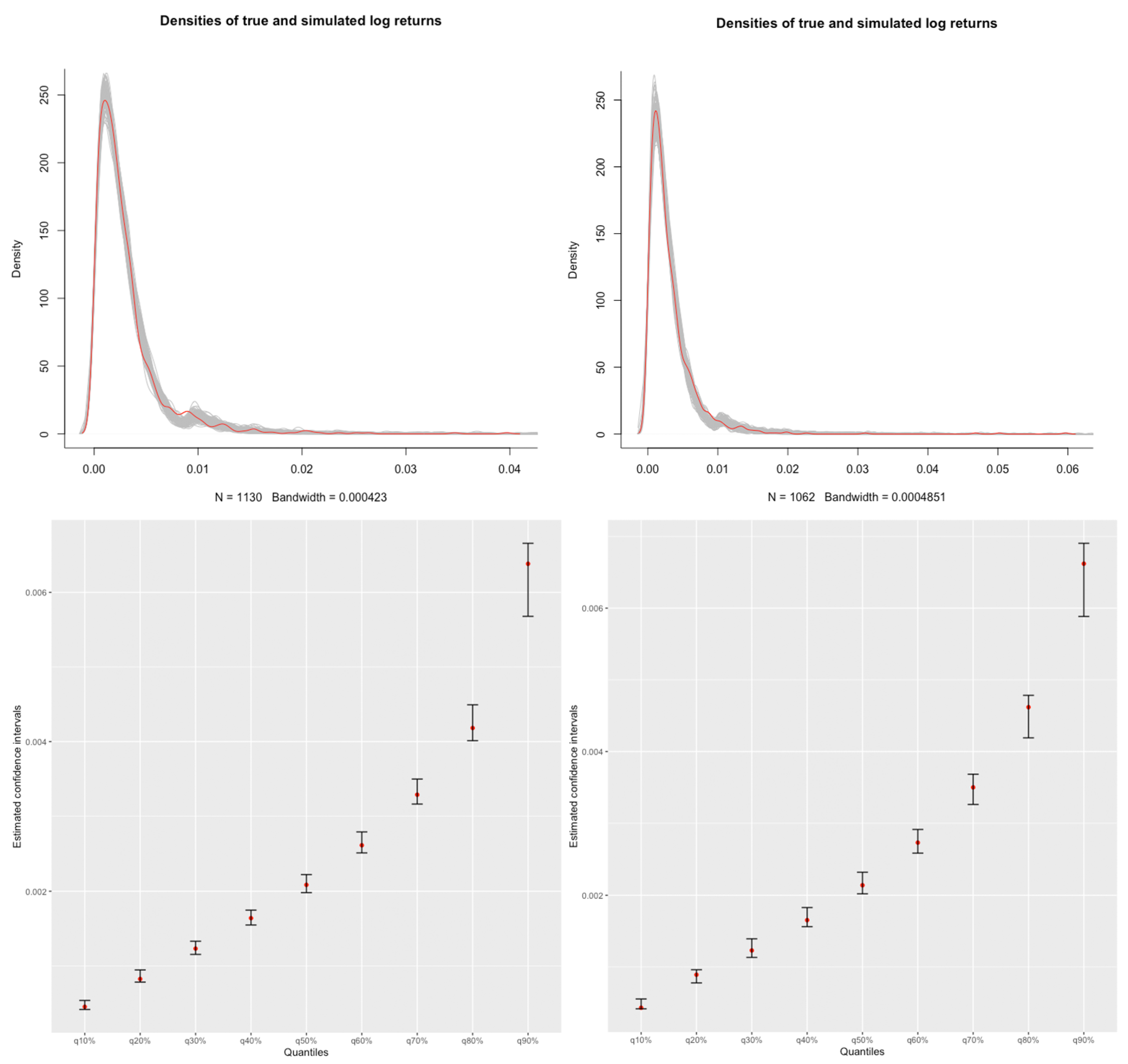
| (8) | (9) | (10) | |
|---|---|---|---|
| (17) | Gumbel | Fréchet | Gumbel, |
| if | |||
| Fréchet, | |||
| if | |||
| Distribution I, | |||
| if | |||
| (18) | Gumbel | Gumbel, | Gumbel |
| if | |||
| no limit, | |||
| if is not fulfilled | |||
| (19) | Gumbel | Fréchet, | Gumbel, |
| if | |||
| if | Gumbel, | ||
| if , | |||
| and | |||
| Distribution II, | Distribution III, | ||
| if , | |||
| and | |||
| if | Distribution IV, | ||
| if , | |||
| and | |||
| no limit, | no limit, | ||
| if | if , | ||
| and |
| Estimates | |||||
|---|---|---|---|---|---|
| Positive log returns | 0.003 | 1.278 | 2.649 | 0.009 | 0.051 |
| Abs. negative log returns | 0.003 | 1.246 | 2.573 | 0.01 | 0.04 |
| Quantiles | 10% | 20% | 30% | 40% | 50% | 60% | 70% | 80% | 90% |
|---|---|---|---|---|---|---|---|---|---|
| Lower CI | 0.416 | 0.783 | 1.154 | 1.548 | 1.982 | 2.509 | 3.164 | 4.013 | 5.679 |
| Estimate | 0.452 | 0.825 | 1.232 | 1.64 | 2.085 | 2.611 | 3.289 | 4.183 | 6.383 |
| Upper CI | 0.537 | 0.946 | 1.33 | 1.747 | 2.223 | 2.79 | 3.498 | 4.493 | 6.657 |
| Quantiles | 10% | 20% | 30% | 40% | 50% | 60% | 70% | 80% | 90% |
|---|---|---|---|---|---|---|---|---|---|
| Lower CI | 0.417 | 0.778 | 1.134 | 1.562 | 2.021 | 2.583 | 3.262 | 4.191 | 5.884 |
| Estimate | 0.431 | 0.892 | 1.231 | 1.654 | 2.14 | 2.73 | 3.501 | 4.619 | 6.62 |
| Upper CI | 0.554 | 0.962 | 1.393 | 1.829 | 2.321 | 2.914 | 3.684 | 4.784 | 6.905 |
Publisher’s Note: MDPI stays neutral with regard to jurisdictional claims in published maps and institutional affiliations. |
© 2021 by the authors. Licensee MDPI, Basel, Switzerland. This article is an open access article distributed under the terms and conditions of the Creative Commons Attribution (CC BY) license (https://creativecommons.org/licenses/by/4.0/).
Share and Cite
Morozova, E.; Panov, V. Extreme Value Analysis for Mixture Models with Heavy-Tailed Impurity. Mathematics 2021, 9, 2208. https://doi.org/10.3390/math9182208
Morozova E, Panov V. Extreme Value Analysis for Mixture Models with Heavy-Tailed Impurity. Mathematics. 2021; 9(18):2208. https://doi.org/10.3390/math9182208
Chicago/Turabian StyleMorozova, Ekaterina, and Vladimir Panov. 2021. "Extreme Value Analysis for Mixture Models with Heavy-Tailed Impurity" Mathematics 9, no. 18: 2208. https://doi.org/10.3390/math9182208





